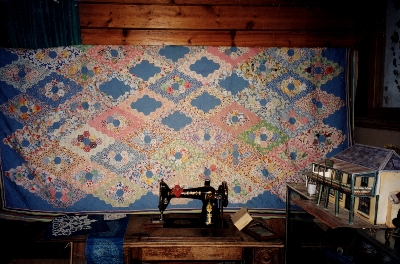Quilt No.466MDH - Mildura and District Historical Society
2439 x 1829mm
The quilt was made in the 1930s by the President and members of the Mildura C.W.A. In the 1970s it was donated to the Mildura and District Historical Society. It is now on permanent display at Langtree Hall, a folk museum of local history that is behind the Cottage in Walnut Avenue Mildura.
This quilt was commenced in the 1930s by the members of the newly formed Mildura branch of the Country Women's Association. Mrs. Edie Lawn was the president. She did most of the assembling and was also a memebr of Mildura Branch of the Embroiderers' Guild. The quilt was completed in 1938 after which it was displayed on special occasions and was always used as a cover on the President's table at the monthly meetings.
Forty years later Alice Farmer, Secretary of the Mildura and District Historical Society, accepted the quilt on behalf of the Society. It was originally in the Historical Society's rooms in the old power house. It is now on permanent loan to Langtree Hall where it is displayed.
Related Quilts:
1620 x 1360mm
2080 x 1650mm
1410 x 1080mm
1400 x 925mm
1860 x 1730mm








